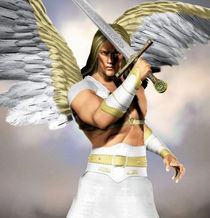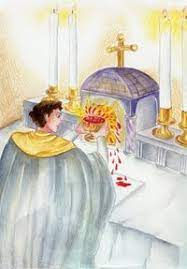The Catholic Defender: Who is the Woman of Revelation 12
- Donald Hartley

- Dec 3, 2022
- 7 min read

This past week on Facebook, I entered into a debate taking place between Catholics and Protestants on a Facebook Friend's page who happens to be Catholic. Often times Anti-Catholics will attack the Virgin Mary and Catholics will defend her. Often times the Woman of Revelation 12 is shown to prove each other's points of view.
I have always understood the woman of Revelation 12 to be the Blessed Virgin Mary because of the content in the text. I also recognize that the Catholic Church also refers to the Church, the body of Christ as the woman. This often points to the connection between the Virgin Mary and the Church as this is closely connected. This happens to be the apostolic tradition as I will try to build the foundation in a few moments.
First, from Scripture, we know that Jesus from the cross gave Mother Mary to St. John the Apostle to be his Mother:

"When Jesus saw his mother, and the disciple whom he loved standing near, he said to his mother, "Woman, behold, your son!" Then he said to the disciple, "Behold, your mother!" And from that hour the disciple took her to his own home." John 19:26-27
Understanding this, it is easy to see St. John recognizing Mother Mary to be the Woman of Genesis 3:15-16:
"I will put enmity between you and the woman, and between your seed and her seed; he shall bruise your head, and you shall bruise his heel." To the woman he said, "I will greatly multiply your pain in childbearing; in pain you shall bring forth children, yet your desire shall be for your husband, and he shall rule over you."

Writing Revelation 12, we see the Woman, the child offspring, and the serpent or the Devil based from Genesis 3:15. We know that the Early Church Fathers recognized the Virgin Mary to be the "New Eve" (Against Heresies by St. Irenaeus 180 A.D.) as Jesus is the New Adam (Romans 5:12-21).
Those opposing Mother Mary will try claiming the Woman of Revelation 12 is ancient Israel while some may see her as an awaiting Israel that is yet to come. They will point to Genesis 37:9-11:
"Then he dreamed another dream, and told it to his brothers, and said, "Behold, I have dreamed another dream; and behold, the sun, the moon, and eleven stars were bowing down to me." But when he told it to his father and to his brothers, his father rebuked him, and said to him, "What is this dream that you have dreamed? Shall I and your mother and your brothers indeed come to bow ourselves to the ground before you?" And his brothers were jealous of him, but his father kept the saying in mind."

Did Jacob or God have the Woman of Revelation 12 in mind with this passage? Revelation 12:1 states, "And a great portent appeared in heaven, a woman clothed with the sun, with the moon under her feet, and on her head a crown of twelve stars; she was with child and she cried out in her pangs of birth, in anguish for delivery." If that be the case, we should find this somewhere in the apostolic witness, the tradition given from Jesus to His Apostles, to their successors.
I will point out here that no one in the Early Church would use scripture the way we do today. The Scripture was not referred to with chapter and verse until the Middle Ages when the Archbishop of Canterbury (England) set the scripture with chapter and verse. So your not going to find a lot of text using scripture and verse in the early Church.

We can however show textual evidence of what the Early Church Fathers taught about text coming from Scripture. Considering some of the earliest writing on the subject of the Woman of Revelation 12, St. Epiphanus, Bishop of Salamis states in a homily he gave around 374-377 A.D. that the Woman was indeed The Virgin Mary.
In his writing, "Panarion" (Bread Box) 350 A.D., St. Epiphanus explains the Assumption of the Blessed Virgin Mary understanding the passages of Revelation 12 as written. He is using the apostolic teaching given to him by his teachers in combating early heresies of his time such as the Arians.

Of the Virgin Mary, St. Epiphanus states, “The first Christians, whose lives are an example for us, showed a loving veneration to the Virgin. In the paintings produced during the first three centuries of Christianity, those that are conserved in the Roman catacombs, the Virgin is contemplated through her representation with the Child God in her arms. We can never be contented in the way we imitate this attitude of the first Christians!"
Many of the Early Church understood the woman to represent the Church, St. Jerome wrote of the Woman using thoughts from Victorinus, Primasius, Tychonius and many others that represented the biblical view at the time. St. Augustine, St. Gregory the Great and Venerable Bede would also address the Woman of Revelation 12 to connect with the Body of Christ the Church and the Blessed Virgin Mary.
There are a lot of examples that provide Mother Mary and the Church to be closely related and connected to the Woman of Revelation 12. This was and is the universal message given in homilies, writings throughout the history of the Church.

Pope Pius X stated, "No one of us does not know that that woman signifies the Virgin Mary, who brought forth our Head with her virginity intact. But the Apostle continues: 'And being with child, she cried out, laboring in birth, and was in pain to be delivered. ' Therefore John saw the Most Holy Mother of God already enjoying eternal happiness, and yet laboring from some hidden birth. With what birth? Surely ours, we who, being yet detained in exile, are still to be brought forth to the perfect love of God and eternal happiness." Ad diem illum. ASS 36. 458 - 59

Pope Pius XII Stated, "We frequently find theologians and preachers who, following the footsteps of the Holy Fathers, use words and events from sacred Scripture with some freedom to explain their belief in the Assumption... . And furthermore, the Scholastic doctors have considered the Assumption of the Virgin Mother of God as signified not only in the various figures of the Old Testament, but also in that woman clothed with the sun, whom the Apostle John contemplated on the island of Patmos." Munificentissimus Deus. AAS 42. 762-63

Pope Paul VI stated, "The great sign which the Apostle John saw in heaven, 'a woman clothed with the sun' is interpreted by the sacred liturgy, not without foundation, as referring to the most Blessed Mary, the Mother of all men by the grace of Christ the Redeemer." Signum Magnum, May 13, 1967 AAS 59

St. John Paul II stated, "she who was the one 'full of grace' was brought into the mystery of Christ in order to be his Mother and thus the Holy Mother of God, through the Church remains in that mystery as 'the woman' spoken of by the Book of Genesis (3:15) at the beginning and by the Apocalypse (12:1) at the end of the history of salvation." Redemptoris Mater, March 15, 1987. Vatican Translation. #24
The foundation is clear from the Early Church Fathers that the Woman of Revelation 12 is the Blessed Virgin Mary, also strongly connected with the Church. What about the idea that the Woman of Revelation 12 is appropriately applied to Israel?

John Nelson Derby (18 November 1800 – 29 April 1882) was a prominent leader of the Plymouth Brethren and Exclusive Brethren groups and is considered to be the "father of modern Dispensationalism and Futurism" which also began the spread of the "Pre-tribulation rapture" teaching that came out of Amsterdam 1830's. Probably best know for his circulation of the Scofield Reference Bible.
Derby began defining the Woman of Revelation 12 to be Israel using his interpretations of Isaiah 9:6:

"For to us a child is born, to us a son is given; and the government will be upon his shoulder, and his name will be called "Wonderful Counselor, Mighty God, Everlasting Father, Prince of Peace."
And Psalm 87:5-6:
"And of Zion it shall be said, "This one and that one were born in her"; for the Most High himself will establish her. The LORD records as he registers the peoples, "This one was born there."
With Derby, as Catholics, we certainly agree the child in Revelation 12:2 identifies with Jesus. I also like Psalms 87:6 probably not as Mr. Derby believed as I see this example to identify where Jesus would be born (Micah 5:2). In the Old Testament, the prophetic word relating to the Church is often seen as Israel. Consider Jeremiah 31:31-32:

"Behold, the days are coming, says the LORD, when I will make a new covenant with the house of Israel and the house of Judah, not like the covenant which I made with their fathers when I took them by the hand to bring them out of the land of Egypt, my covenant which they broke, though I was their husband, says the LORD."
Jesus will fulfill this promise at the Lord's Supper:
"Now as they were eating, Jesus took bread, and blessed, and broke it, and gave it to the disciples and said, "Take, eat; this is my body." And he took a cup, and when he had given thanks he gave it to them, saying, "Drink of it, all of you; for this is my blood of the covenant, which is poured out for many for the forgiveness of sins." Matthew 26:26-28

So, when looking at who the Woman of Revelation 12 actually is, the Catholic Church can literally go all the way back to apostolic times. Those pushing the Israel connection specifically as to deny the Church and the Virgin Mary, comes from the 19th century founding of Dispensationalism.
The Catholic Church alone stands on solid ground.
“And a great portent appeared in heaven, a Woman clothed with the sun, with the moon under her feet, and on her head a crown of twelve stars; she was with child and she cried out in her pangs of birth, in anguish for delivery. . . . [S]he brought forth a male child, one who is to rule all the nations with a rod of iron, but her child was caught up to God and to his throne. . . . Then the dragon was angry with the Woman, and went off to make war on the rest of her offspring, on those who keep the commandments of God and bear testimony to Jesus” (Rev. 12:1–2, 5, 17).





















Comments